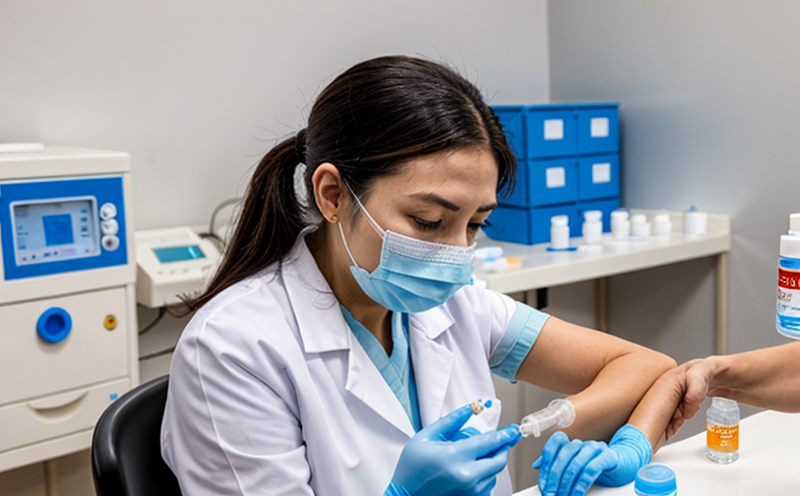USP Residual Antibiotic Testing in Vaccines
The United States Pharmacopeia (USP) sets standards and guidelines for ensuring that pharmaceutical products are safe and effective. One critical aspect of this is the testing for residual antibiotics in vaccines, a process known as USP Residual Antibiotic Testing. This service ensures that vaccines do not contain harmful levels of antibiotics, which could interfere with their efficacy or cause adverse reactions.
The presence of antibiotics in vaccines can be due to various reasons such as contamination during manufacturing processes, the use of antibiotic solutions for preservation, or the use of antibiotics to prevent bacterial contamination. The goal of this testing is to ensure that these agents are present only at levels that do not affect the safety and efficacy of the vaccine.
The methodology involves several steps including sample preparation, extraction, and analysis using high-performance liquid chromatography (HPLC). This process ensures accurate detection even in trace amounts. The USP guidelines specify acceptable limits for antibiotic residues based on the type of vaccine being tested and its intended use.
Proper adherence to these standards is crucial as it helps maintain public trust and regulatory compliance. Failure to comply can lead to product recalls, legal issues, and potential harm to patients. This service not only ensures that vaccines meet stringent quality assurance criteria but also contributes significantly to healthcare safety and patient well-being.
The importance of this testing cannot be overstated, especially in light of the increasing global focus on antibiotic resistance. By ensuring that antibiotics do not persist in vaccines, we can help mitigate one source of antimicrobial pressure on bacteria. This aligns with broader efforts to preserve the effectiveness of antibiotics for treating infections where they are truly needed.
Understanding the implications of residual antibiotics is essential for all stakeholders involved in vaccine production and distribution. For quality managers and compliance officers, this service provides peace of mind regarding regulatory adherence. R&D engineers can rely on it to refine their processes further reducing antibiotic residues without compromising product integrity. In summary, USP Residual Antibiotic Testing plays a vital role in safeguarding public health while maintaining the highest standards of pharmaceutical manufacturing.
Scope and Methodology
The scope of this service encompasses the testing for residual antibiotics in vaccines according to USP guidelines. It involves detailed sample preparation, extraction methods tailored to different types of vaccines, and analysis using advanced chromatographic techniques.
Sample Preparation: The process begins with careful selection and handling of vaccine samples to prevent contamination or degradation. This step is crucial as any alteration in the sample can lead to inaccurate test results.
Extraction Methods: Depending on the type of vaccine, specific extraction methods are employed to isolate antibiotics from other components. Common techniques include solvent-based extractions and solid-phase extraction (SPE). SPE is particularly useful for removing interfering substances that might interfere with the detection process.
Analysis Using HPLC: High-performance liquid chromatography is used to separate, identify, and quantify antibiotic residues in the sample. This technique allows for precise measurement even at very low concentrations. The use of appropriate detectors such as ultraviolet-visible (UV-Vis) or mass spectrometry (MS) enhances accuracy.
The methodology also includes calibration standards and quality controls to ensure reliable results. Calibration ensures that instruments are operating within specified parameters while quality controls help verify the integrity of each test run. Compliance with USP guidelines guarantees consistent, accurate testing across all samples processed.
Industry Applications
| Vaccine Type | Treatment Indication | Residual Antibiotic Limits (USP) | Testing Methodology |
|---|---|---|---|
| Influenza Vaccine | Influenza Prevention | <10 ng/mL for penicillin and cephalosporins | HPLC with UV detection |
| Measles-Mumps-Rubella (MMR) Vaccine | Viral Infections in Children | <5 ng/mL for tetracyclines | SPE followed by HPLC-MS/MS |
| Pneumococcal Conjugate Vaccine (PCV) | Prevention of Pneumonia and Meningitis | <2 ng/mL for macrolides | HPLC with MS detection |
| Diphtheria-Tetanus-Pertussis (DTaP) Vaccine | Vaccination of Infants Against Tetanus, Diphtheria and Pertussis | <1 ng/mL for aminoglycosides | Advanced SPE coupled with HPLC-UV detection |
This table provides an overview of different vaccine types commonly tested, their primary treatment indications, the specified limits for residual antibiotics according to USP guidelines, and the methodologies employed in testing. Each entry highlights the specific focus areas within the broader context of pharmaceutical quality assurance.
International Acceptance and Recognition
The United States Pharmacopeia's Residual Antibiotic Testing is widely recognized and accepted globally for its stringent standards and reliable testing methods. Regulatory bodies across numerous countries have adopted USP guidelines as part of their quality assurance programs.
For instance, the European Medicines Agency (EMA) recognizes USP standards for residual antibiotic testing in vaccines. Similarly, the World Health Organization (WHO) includes these tests within its recommended protocols to ensure vaccine safety and efficacy. Many national drug regulatory authorities also align with USP guidelines to maintain high standards of pharmaceutical quality.
International acceptance extends beyond just regulatory bodies; leading pharmaceutical companies incorporate USP standards into their internal quality control processes. This ensures consistency in testing practices across different geographical regions, fostering trust among consumers worldwide.
The recognition of USP residual antibiotic testing underscores its significance in maintaining global health standards. By adhering to these guidelines, manufacturers contribute not only to local but also international public health objectives. This harmonization supports the broader effort towards safer and more effective vaccines for everyone globally.





